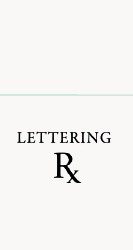Mara Zepeda • Neither Snow — Part I
I have been wanting to know more about Mara Zapeda for ages now, just like Betsy Dunlap I was intimidated to reach out, doing these interviews the fear of being ignored or rejected is always on my mind, but luckily most lettering artists have been more than accommodating, even with their full schedules, it makes this lettering-phile happy to no end! Mara not only complied for lack of a better description she ‘brought it’, so much so that we are compelled to make this a Part I + Part II, there’s just way too much great information here for you and way too many beautiful images
Where are you located?
After living for years on the east coast (Philadelphia and Boston) then pinballing from Los Angeles and Florence, Italy, I am happily settled in Portland, Oregon. Everything you’ve heard is true: it is an incredible city.
I am so curious about the name ‘neither snow’, I know it’s from the U.S. Post, but I am dying to know how you decided upon this? Did you read it standing on line and it resonated? It’s so charming and genius.
Thank you! I started Neither Snow in the summer of 2009, right before my own wedding. I went to Reed College (more on that later) where we read Herodotus’ Histories. The quote originates there and was then adopted and adapted by the US Postal service as its well-known motto, which I’ve admired for years on the facade of the New York Central Post Office. I liked that it referenced both my time at Reed and the nostalgia surrounding hand delivered mail.
How did you get started in lettering?
My mother was a calligrapher so I grew up around light tables and bottles of Windsor & Newton ink, shrieks of horror at an errant blob of ink ruining the final line of a commission, and easy access to pens and nibs. I studied collage with the artist Gail Rieke in Santa Fe, New Mexico as a teenager. While Gail wouldn’t call her lettering calligraphy, it transmits so much beauty and soul, especially in her astonishing collage journals. She turned me on to the work of Lenore Tawney and Joseph Cornell. Again, they are not calligraphers but, more than any others, I was influenced by these artists’ worldview, and the way they incorporated lettering into their work.
Reed has a storied history of calligraphy. Lloyd Reynolds started the program, which inspired countless Pacific Northwest calligraphers, poets, and artists, not to mention students across departments. (This image of calligraphed library circulation cards just kills me). Some people might be familiar with it from Steve Jobs’ famous Stanford commencement speech in which he speaks about his calligraphy teacher, Robert Palladino, and the influence that sensibility had on the design of the first Macintosh computer. In fact, some of the earliest Adobe typefaces used on Macs were designed by Reed alumni.
Reed’s scriptorium program sadly didn’t exist while I there (but it doesn now and it is amazing). While in college, I started my formal italic study in New York City, with Paul Werner. Then I went on to study Copperplate with Carole Maurer in Philadelphia. At a certain point, I faced the hard truth that I was (and continue to be!) a terrible traditional calligrapher. Replicating traditional letterforms was neither my strength nor interest. This was around the time that groundbreaking artists like Betsy Dunlap started create work with such vivacity and personality. Betsy’s trailblazing encouraged the early generation of modern pointed pen calligraphers. Her influence cannot be overstated. (I wrote more about my inglorious start here).
Continue reading part two of Mara's interview here.
Mara's Shopping List
Nikko G nib
Moon Palace Sumi ink
Dr. Martin’s Bleed Proof White
Canson Pro Layout Marker
Mastering Copperplate Calligraphy by Eleanor Winters
Italic Calligraphy and Handwriting by Lloyd Reynolds
Modern Calligraphy by Molly Suber Thorpe









